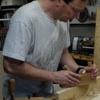Hi guys, I am going to learn how to cut dovetails by hand I have used power tools to cut them in the past but I want to be able to cut them by hand. I guess I will start with the tools I am looking at and ask for your help in deciding on a saw and a chisel / set. I have been looking at the Veritas® Molded-Spinedovetail saw and the Narex bench chisel set any thoughts on these tools do any of you have experience with these?
I also picked up the FWW dvd while it was on sale so I am reading all they have on dovetails. With all that said what advice would you offer someone new to working with hand tools and wanting to learn dovetails?
Thanks,
Cory




 Reply With Quote
Reply With Quote









